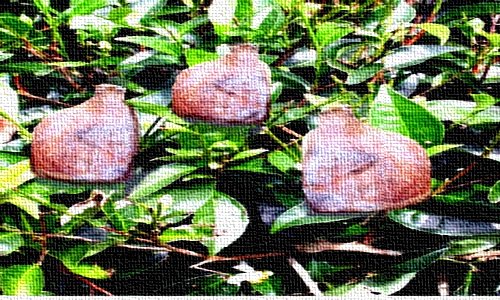BY LETTER
Artificial Meat Production
 Image from Steve Bowers | |
| Artificially cloned and cultured meat hamburger (hamburgers are layered hand meals popular in the Terragen Federation) | |
Raising animals for meat production is an ancient form of farming, which on a Gaian type world or habitable megastructure may occur on rich pasture land or utilise otherwise marginal land through area-extensive pastoral techniques. However on smaller worlds, and in domed colonies and rotating habitats, and within closed environments such as worldships, there is rarely enough room for free range animal husbandry. Meat production generally uses more energy input to produce a given amount of consumable food than other forms of agriculture, although the meat products produced have very high nutritional value.
Genetically engineered, low maintenance food animals have been available since the Interplanetary Age, some descended from the original Mambo Chickens and Squarepigs developed by the Genetekkers in the old Solar System. These creatures are almost always entirely sessile, and almost completely fill their containment pens when adult. Some are segmented or capable of regenerating removed limbs or other body parts, thereby prolonging the productive life of the animal. Such food animals are generally well cared for and content, often because they have been designed to integrate with their pens and support systems both physically and mentally. Some cultures prefer meat from geneered food animals, and this form of meat production is quite widespread, especially among Genen clades; but the production of cultured or vat-grown artificial meat is much more common throughout the civilized galaxy.
Vat-grown, or printed, meat products are produced using the same basic techniques as other forms of printed tissue culture. Tissue engineering of this type was first developed for medical use in the production of autologous tissue for organ replacement. However this sort of tissue culture was soon found to be useful for the direct production of meat for food on spacecraft and habitats in deep space.
To achieve the goal of meat production, muscle and other flesh cells are grown on a specially constructed biopolymer scaffold, which replicates the natural extracellular matrix found in living animals. This scaffold is generally printed using a rapid 3D printer device, although several other related techniques such as foaming and self-assembly are also used. Cultured cells are then implanted into the scaffolding, and these cells are induced to bind together into muscle-like or vascular tissue.
Image from Steve Bowers | |
| An artificial meat frame, where muscle tissue is exercised to improve flavour | |
Once the meat block, known as `slab', is established, the tissue is supplied with nutrients and allowed to grow by as much as 400% by volume before harvesting. To ensure the slab has a healthy texture it is stimulated into regular contractions, simulating exercise; the slab is attached at each end to strain gauges to measure the force of contraction. Each slab is connected to a generous supply of nutrient fluid often closely resembling blood.
As well as beef, pork, chicken and lamb slab, many other meats are grown including llama, kangaroo, horse, elephant, whale and pheasant. Reptile, amphibian and fish slabs are popular, as are various invertebrate tissue cultures. These cold-blooded meats use less overall energy input to produce than warm blooded varieties.
More exotic meats such as geneered sea-dragon, pterodactyl and selected xenofauna are well-established speciality products, and premarinated flesh is becoming increasingly popular. Cloned human flesh is sometimes available, particularly personalised meat for autophagists and the well known range of Klown Klone products which allow the consumer to eat the celebrity of their choice.
 Image from Steve Bowers | |
| A hambush, another method of producing artificial meat where animal tissue is grown on a genetically modified plant | |
Related Articles
Appears in Topics
Development Notes
Text by Steve Bowers
Initially published on 13 March 2007.
Initially published on 13 March 2007.






